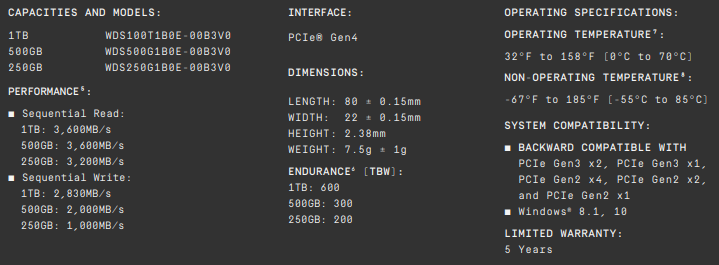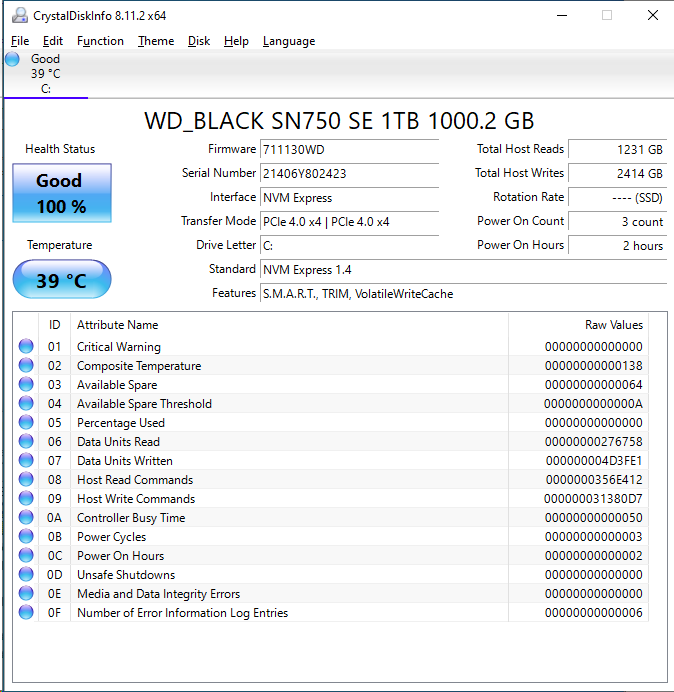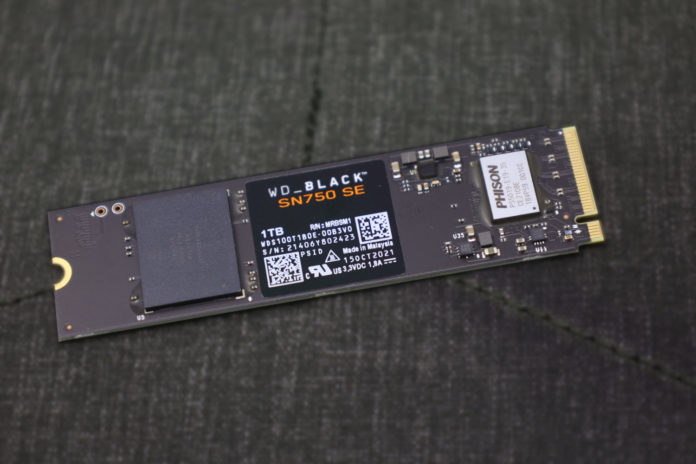Today we are taking a look at the WD Black SN750 SE 1TB NVMe SSD. This is a somewhat odd drive, in my opinion, in that it is technically a PCIe 4.0 update to the WD Black SN750 drive, but the performance specifications for the drive have not increased in line with the move to the faster PCIe interface. In addition, the SN750 SE is a DRAM-less drive, whereas the previous SN750 had a DRAM cache. I will reserve judgment until after the testing is done of course, but I am fully expecting to be a bit confused by the end of the review!
WD SN750 SE 1TB NVMe SSD
The WD SN750 SE 1TB comes in a single-sided M.2 2280 (80mm) form factor.

Physically the exterior of the SN750 SE looks very similar to the WD Blue SN550; an almost barren-looking PCB with only a couple of major components. We have a single SanDisk/WD NAND package containing TLC flash. Separated by some physical space on the PCB we find the Phison PS5019-E19 controller. The presence of the Phison controller itself is unusual since WD typically uses its own controller designs on its SSDs. In another similarity to the WD Blue SN550, there is no DRAM cache and instead, host memory buffer (HMB) technology is used.

The rear of the drive has a bunch of logos, but nothing else.
WD SN750 SE Specs
The WD SN750 SE line of SSDs comes in at capacities between 250GB and 1TB.

If the WD SN750 SE was a PCIe 3.0 drive, these specs would be great; on a PCIe 4.0 drive, they are very underwhelming. 3600 MB/s read speed is a bit ahead of the original SN750, but 2830 MB/s write speed falls short of the original SN750. Neither of these rated performance levels gets anywhere near pushing the boundaries of a PCIe 4.0 connection and will not hold up well compared to other PCIe 4.0 drives. The 1TB drive sports 600 TBW endurance, which is seemingly the standard for a 1TB drive and matches the previous SN750. We do at least feature the 5 year warranty that has come to be standard for premium SSDs.

CrystalDiskInfo can give us some basic information about the SSD, and confirms we are operating at PCIe 4.0 x4 speeds using NVMe 1.4.
Test System Configuration
We are using the following configuration for this test:
- Motherboard: ASUS PRIME X570-P
- CPU: AMD Ryzen 9 5900X (12C/24T)
- RAM: 2x 16GB DDR4-3200 UDIMMs
Our testing uses the WD SN750 SE 1TB as the boot drive for the system, installed in the M.2_1 slot on the motherboard. The drive is filled to 85% capacity with data and then some is deleted, leaving around 60% used space on the volume.
Next, we are going to get into our performance testing.





I’m thinking less “marketing gimmick” and more “want to meet the minimum requirements for a PS5”, as they require Gen4 drives.
aetherspoon,
PCIe 4.0 compatibility is not all that is ‘required’ to be PS5 compatible. By Sony’s documentation drives must also be capable of 5500 MB/s sequential read rates, which this drive does not approach. Gimmick.
The only reason PCIe 4.0 would be useful for this drive is if you had a PCIe 4.0 M.2 x2 slot, but I don’t know of any PCIe 4.0 system that has only M.2 x2 and not x4.
I had the same thought Chris, and the 2nd slot on the ASUS Pro WS X570-ACE (my motherboard) is a PCIe 4×2 slot that I use for my OS drive (and keep the CPU connected top slot @ PCIe 4×4 for my high performance drive).
@Chris S:
The Supermicro H12SSW series comes to mind, although it does not apply to all variants. I don’t know how many customers will place a consumer SSD on such a board, but do care about the better performance of gen4 and pay the premium…
@Chris S : The XSS expansion cards are PCIE4x2. I remember someone making an adapter- this drive along with the adapter should be a cheaper option than the official cards.
Like the commenter above, I also have a ASUS X570-ACE with a second m.2 PCIe 4.0 x2 slot that is connected to the PCH. Doesn’t really make sense to use a top of the line PCIe 3.0 drive (because it can never use all 4 lanes), and doesn’t really make sense to use a top of the line PCIe 4.0 drive either. This fits the niche perfectly.
I’m also buying a Dell workstation that has a PCIe 4.0 x4 m.2 slot connected through the PCH, where there won’t be enough bandwidth for a full x4 drive.
So there is a niche this fits.
Will, thanks for this article. I had not noticed the addition of “SE” to the online listings for WD 750’s… and I am in the market for a new SSD. Had I not seen this report I probably would have blithely bought what I thought was a WD 750.
Effectively this move raises the price for decent perf from WD. I am not seeing “750” for sale anyore just “750SE”. CA135 750SE, CA225 850, 1TB. Nothing in between.
I still bought this anyway for my TUF F15 gaming (2022) because it is slightly better than the pre-installed intel one, and because only a handful of games will actually benifit in load times if I got soemthing fancier honestly.